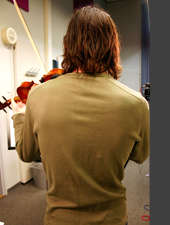
Twist -Daniel before the research, Nov. ’03
A violinist or violist rarely sees himself from behind. By photographing and filming the musicians from behind before and after the research we could note the changes in the back.
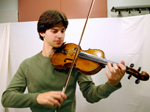
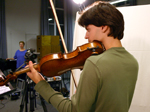
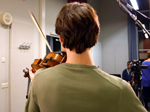
What looks relaxed from the front, looks different as you walk around the violinist. Jorge before the research, Nov. ’03
Before we started the project we noticed that many of the musicians were twisting their backs in order to hold the instrument. At the end of the school year, after the re-training period combined with changes to their equipment, symmetry in the back was re-established.
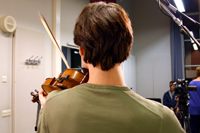
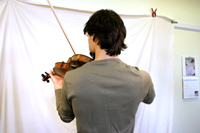
1. A raised and locked left shoulder and shoulder blade Jorge before the research, Nov. 03
2. Shoulders match each other, shoulder blades even Jorge after the research, June 05
In the best scenario, the spine is lengthened and the ribs are free to move, with the entire torso actively supporting the shoulder girdle. The shoulder blades can slide easily across the back allowing the arms to move freely.
The back reflects the struggle to hold the instrument securely and still be able to move freely. How you hold the instrument is crucial, but the player with ill-fitting chin and shoulder rest often has limited choice of how to hold the instrument. Clamping the instrument between head and shoulder by pressing downward and to the left with the head, while pressing up an forwards with the left shoulder, can restrict the movement of the back muscles and twist the entire torso. Both arms then have to work against this rigidity and asymmetry as they move.
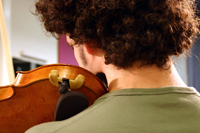
Surprisingly, the twist in the back begins just under the chin – pressure exerted downwards locks the head in one place – immobilizing the spine from the top down. When the chin rest is not suitable, the player must “look” for it with the chin, pushing the chin down and to the left, increasing pressure and distorting use of neck muscles. Any disturbance in the neck muscles affects the whole spine.
The twist in the spine begins in the neck
Pain between the shoulder blades
In the further struggle to keep the instrument in place, the left shoulder blade is often pushed up and forward, immobilizing the left side of the shoulder girdle. An immobilized left shoulder blade affects the left hand technique, and it also affects the bow arm. Any tension in the left side of the body is immediately echoed in the right side. With the left shoulder blade pulled up and forward, the right shoulder blade must pull against the tension it in order to bow. This causes tension between the shoulder blades, something of which players often complain. Immobility of the shoulder blades can also lead to strain in the shoulder joint of the right arm. Both the shoulder rest and the chin rest must be adjusted properly in order to allow the musician to avoid these tensions.
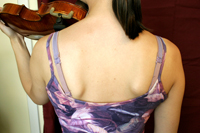
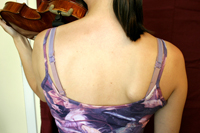
Left shoulder blade disappears as the violinist brings the shoulder forward to secure the instrument.
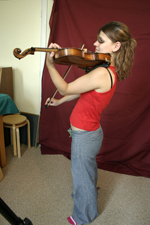
Throwing the upper back backwards
The struggle in the back is made worse for smaller and middle-sized players when the position of the instrument is too far to the left for easy bowing. Overstretching the right arm to reach the tip of the bow pulls the right shoulder blade forward and out of its normal range of movement. This increases the tension between the shoulder blades.
When players cannot reach the tip of the bow at all or only with difficulty, they tend to throw the upper body backward in order to complete a long down-bow. This provides a temporary solution to their bowing problem by moving the violin away from the bow, enabling them to bow to the tip. For every down-bow, this backwards movement has to be repeated at a cost to the back of the player, and a loss of balance.
Throwing the upper body backwards to reach the tip of the bow.
Players must struggle to keep the bow straight when the violin is not properly aligned to their bow arm. With the left arm shortened to hold the violin in place, and the right arm overstretched to reach the tip of the bow, the upper back becomes the site of a great deal of tension, often experienced by players as pain.
Losing length and width
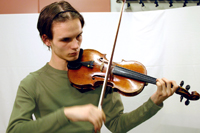
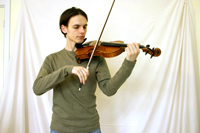
1. Daniel before the research, Nov. ’03
2. Daniel after the research, June ’04
Players whose equipment is not properly adjusted to their size tend to fold themselves around the instrument, shortening their stature. When the chin rest is not properly adjusted to length of neck, then the musician not only pulls his head down to fill the gap, but also often raises the whole shoulder girdle (collar bones and shoulder blades) which brings the shoulders and back into constant tension. Over time this can lead to a general decrease in length and width of the torso, and cramped use of all the musculature of the back and chest. Since the arm muscles originate in the torso, arms and hands are also affected.
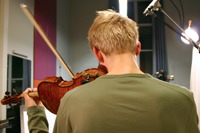
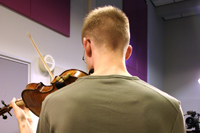
1. Shortening the spine by pulling the head down, Huug before the research, Nov. ’03
2. The spine lengthened, head on top of spine. Huug after the research, June ’04
Violinists and violists lose track of where their heads are by the constant pressure downwards that is often exerted in order to hold the instrument. With well-fitted equipment, the need for shortening and twisting is removed. Weekly lessons in the Alexander Technique help the musicians to re-discover their overall length and width, learning to steer their playing with a healthy use of the spine.

